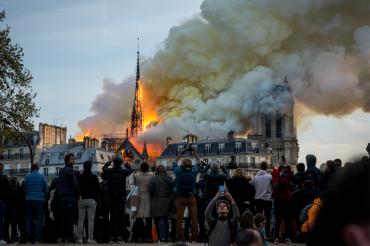Rebuilding Notre Dame: U of T expert on the history and future of the iconic cathedral

Published: April 16, 2019
Hundreds of millions of euros have already been pledged by wealthy donors and major corporations to restore Notre Dame, the iconic Gothic cathedral in Paris that was severely damaged by a massive fire on Monday.
People around the world watched as the cathedral’s spire toppled in the flames, waiting with bated breath to find out if the 850-year-old cathedral would survive.
Thankfully, the structure of the cathedral was saved, and many of the important relics and works of art were taken out of the building – with only minor injuries to two police officers and a firefighter reported.
Notre Dame had remained remarkably unscathed during its centuries-long history, avoiding destruction during both the First and Second World Wars, and only suffering some damage and vandalism during the French Revolution.
Yet, despite avoiding a major disaster, the cathedral has seen a great deal of change over the past eight centuries, says Paul Cohen, an associate professor of history at the University of Toronto.
“The building we visited until yesterday afternoon – for those of us who have been to Notre Dame – is the 13th-century structure but also, like all the great Gothic cathedrals that have survived, it has been an evolving and changing, constantly maintained, constantly rebuilt, and constantly reconstructed structure,” he says. “It looks different than it was, it functions differently than it did.”
The spire, for example, was only built in the 19th century when Eugène Emmanuel Viollet-le-Duc, an architecture historian and lover of medieval architecture, led a large-scale renovation of Notre Dame, says Cohen.
“There are a lot of features with Notre Dame that we closely associate with the cathedral today that are his,” he says – including a lot of the statuary and the gargoyles.
Notre Dame’s ever-evolving structure offers a degree of hope for the future of the cathedral.
“It's been constantly reinvented over the centuries so this will be the latest reconstruction,” Cohen says.
U of T News spoke with Cohen about Notre Dame’s history and significance, as well as the efforts to fund its reconstruction.
What is it about Notre Dame that resonates with people around the world?
As one of the greatest examples of Gothic architecture in the 12th and 13th centuries, it's a spectacular and remarkable structure, from the sense of space in the interior – for any who have had the good fortune to visit Notre Dame – to the flying buttresses around the outside, to the extraordinary front facade and perhaps most extraordinarily the stained glass, the three rose windows, which, based on reports, appear remarkably to have survived.
 It was built with a specifically spiritual and confessional purpose in mind as a seat for an archbishop and a space for Christian Catholic worship. But it was also built to create a sense of awe, of spectacle, of community – of a social experience – and it still succeeds at doing that even for people who aren't Catholic or Christian. That's part of the reason it is by some measures the most visited monument in Europe.
It was built with a specifically spiritual and confessional purpose in mind as a seat for an archbishop and a space for Christian Catholic worship. But it was also built to create a sense of awe, of spectacle, of community – of a social experience – and it still succeeds at doing that even for people who aren't Catholic or Christian. That's part of the reason it is by some measures the most visited monument in Europe.
There are other reasons as well. The fact that it's in the very centre of Paris – it's a symbol, it's an iconic monument in an iconic city in the number one tourist destination in the world, in an age where mass tourism is an extraordinarily important social phenomenon.
It's a building that's entered popular culture in a way that is way beyond the religious dimensions. It's a process that really begins in the 1830s with the French writer Victor Hugo's novel Notre-Dame de Paris, which, like all Hugo's novels is a bestseller. It both relocates Notre Dame in the space of literature, popular culture, and also creates the framework for 20th and 21st century reinventions in popular culture.
What were some of the features of the cathedral that were saved in the Notre Dame fire?
There is some happy news amidst the sadness. It appears the three great stained glass roses have survived, and the organ, which was recently renovated at considerable cost. It appears that the vaulted ceiling protected the interior of the church, with the exception of the place where the steeple collapsed through it.
Most of the interior artwork, the wall around the choir behind the main altar, the altar itself, the side chapels – it appears they are in tact. There's no doubt there will be a lot of water damage but it could've been much worse.
Hundreds of millions of euros have already been pledged for the rebuilding and restoration of Notre Dame. Does this give the international community hope for the future of the building?
It doesn't take away the sadness and the loss. There are things that can't be replaced: the wood frame underneath the roof was an extraordinary latticework of enormous oak wood beams. Most of those were the original beams from the 13th century. Those can't be replaced – there are no 13th century wood beams around and I think an entire forest was felled to build the roof of Notre Dame.
There were some relics that were placed in the steeple that collapsed and burned yesterday, which can't be replaced. There are irreparable losses but, from the moment the fire began, there was never any question it wouldn't be rebuilt. Its symbolic importance in France is just too important.
The French state, the private donors, will rapidly mobilize the resources. France, like Italy, like Germany, has the technological know-how and the human power, the skilled labour to be able to do it because they're constantly rebuilding and renovating these structures. There are whole arms of the culture ministry and there’s a constellation of contractors and businesses that can do this kind of work.
This, of course, is a privilege reserved for wealthy, industrialized countries. That's not the case everywhere. Think of what's been destroyed, say in Syria – in Aleppo or Palmyra and so forth – or what took place in Afghanistan.
A number of opinion pieces have been published by French and European writers who say the fire is a reminder not to take important monuments like Notre Dame for granted. What do you make of that?
That's absolutely right. I think that's a lesson everyone looking at the live footage, or was thinking about this yesterday, thought. I'm half French and spent a good part of my life in Paris and I certainly felt that.
Anyone who has visited Notre Dame, or any of the other great Gothic cathedrals, can't but help come away with a sense of solidity and eternity. They were designed to evoke that – the eternity of God's creation, of God's judgement and so forth. But also, they're big, they're built with stone-supporting walls – for the most part they're in great shape.
To a very real extent, the notion that these were eternal, were here to stay and were something we could take for granted is something that maybe is rather new.
But I think it's important to keep in mind that there's a long history of damage and destruction that buildings like Notre Dame have suffered. Fire was the bane of big church buildings in the Middle Ages and in the construction of cathedrals.
My mother was born in Paris and grew up during the Second World War. It's easy for generations since then to forget that the generation of our parents remember very well the great Reims Cathedral – one of the great European Gothic cathedrals, in some ways equally as important as Notre Dame, that was very nearly destroyed in 1914 in the First World War under German shelling and the great Rouen cathedral, one of the jewels of medieval Gothic architecture in the capital of Normandy, that was very heavily damaged in 1944 by British bombing.
There is a long history of the great monuments like Notre Dame being partially damaged or completely destroyed. The long period of peace in Western Europe and the West meant that we had forgotten that history.
In a fire that bares uncanny resemblance to last night's fire: In the French city of Nantes, the cathedral of Nantes was undergoing renovations in 1972 and a worker's blow torch caused a fire that burned the wood roof of the cathedral.
It shows that sadly, for a building this old, these things happen. [Nantes] has been rebuilt – the roof was quite rapidly rebuilt and a full renovation was just completed a few years ago.
What was it like for you seeing Notre Dame for the first time?
I'm not sure I have a memory of the very first time, but from the first memories I have of it as a child, the great Gothic structures were deeply impressive to me.
There is something about the Gothic aesthetic that speaks to our modernity – the flamboyance of the flying buttresses, the gargoyles and the extraordinary sculptural narrative of the last judgement which is on the west facade.
It was designed to inspire awe and wonder and to create a social experience. This was a building designed to gather large numbers of people inside. It still does that, whether for Catholic masses or just from being the most visited monument in Europe by some measures. Any five-year-old boy or girl will feel that walking in.



